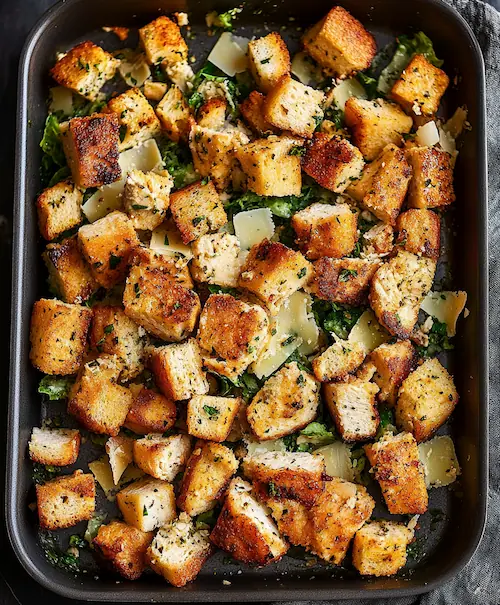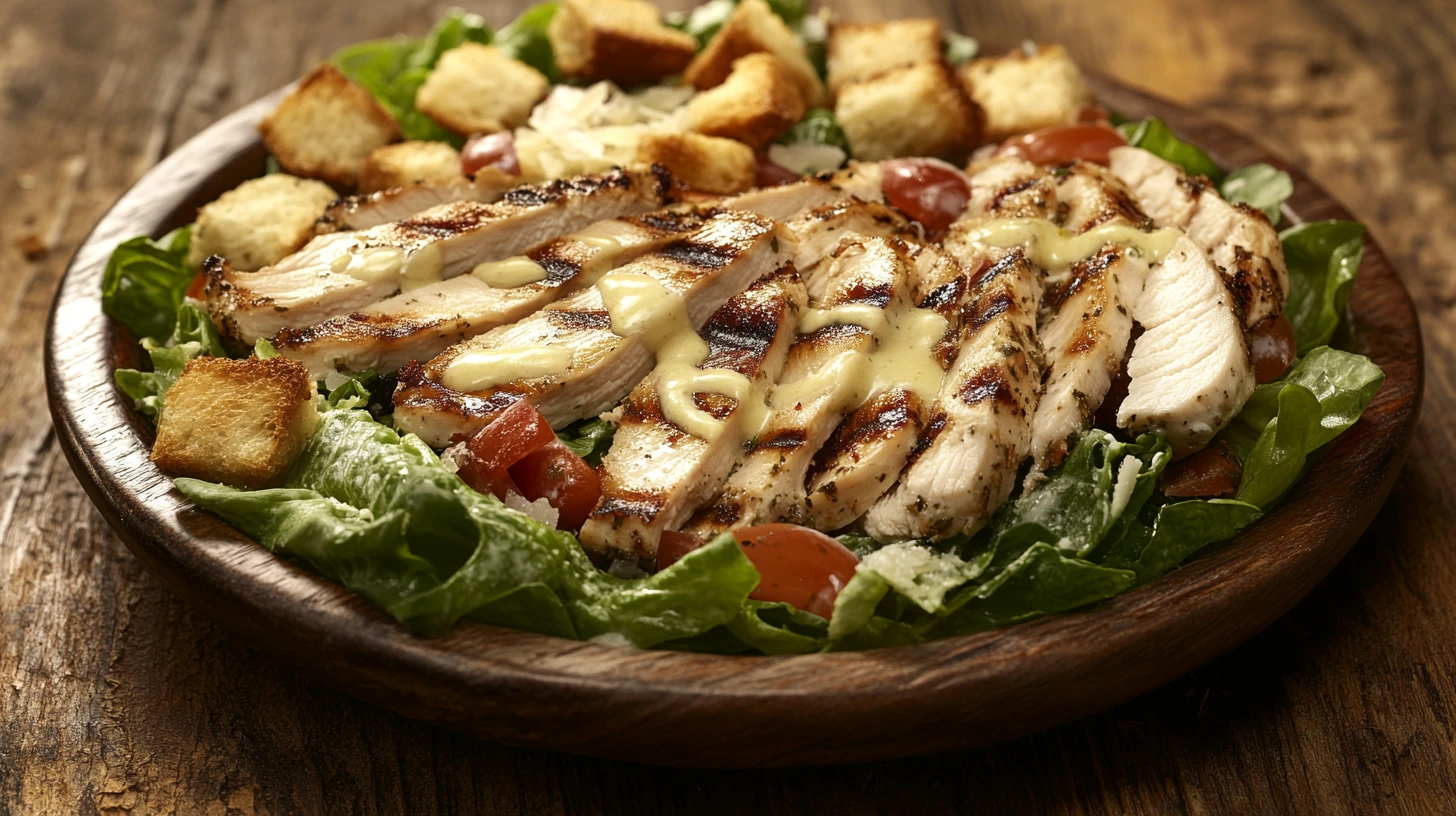When it comes to iconic dishes that blend flavor, nutrition, and versatility, Chicken Caesar Salad reigns supreme. This timeless classic, celebrated in homes and restaurants worldwide, owes its charm to the harmony of crispy romaine lettuce, tender grilled chicken, crunchy croutons, and a savory Caesar dressing.
Whether you’re looking for a light lunch, a side dish, or even a satisfying dinner, Chicken Caesar Salad fits the bill. It offers a perfect balance of protein, healthy fats, and carbohydrates, making it not only delicious but also a wholesome choice.
In this guide, we’ll dive deep into everything there is to know about Chicken Caesar Salad. From its storied origins to the nuances of preparation, nutritional insights, and creative variations, this article serves as the ultimate resource for mastering this classic dish.
Table of contents
The History of Caesar Salad
Origins of the Caesar Salad
The story of Caesar Salad begins in 1924 with an Italian immigrant chef named Caesar Cardini, who worked in Tijuana, Mexico. According to culinary lore, the salad was born out of necessity when the restaurant experienced a shortage of ingredients. Caesar combined simple items like romaine lettuce, olive oil, egg, Parmesan cheese, and Worcestershire sauce to create the now-famous dish. It became an instant hit with patrons, earning its place in culinary history.
The original recipe lacked chicken, which was a later addition that elevated the salad into a more substantial meal. Its simplicity and adaptability made it a favorite across different cultures and cuisines.
The Evolution of Chicken Caesar Salad
Chicken was incorporated into the classic Caesar Salad much later as a way to add protein and satisfy heartier appetites. Over time, other variations emerged, incorporating ingredients like bacon, avocado, and even seafood, while keeping the essence of the original intact.
Key Ingredients
Classic Components of a Chicken Caesar Salad
The traditional Chicken Caesar Salad consists of the following key ingredients:
- Romaine Lettuce – The backbone of the salad, providing a crisp and refreshing texture.
- Grilled or Roasted Chicken – Adds protein and depth to the dish. Chicken breast is a popular choice for its lean and tender qualities.
- Croutons – Crunchy bread pieces, often toasted or fried with seasoning for added flavor.
- Parmesan Cheese – Grated or shaved, it delivers a salty and nutty profile that elevates the dish.
- Caesar Dressing – Made with a blend of olive oil, anchovies, egg yolks, garlic, lemon juice, Dijon mustard, and Worcestershire sauce, it’s the heart of the salad.
Variations and Modern Twists
While the classic recipe remains popular, many variations have emerged:
- Greens Substitutes: Spinach, kale, or arugula for added nutrients and flavor diversity.
- Protein Alternatives: Grilled shrimp, salmon, or even tofu for vegetarians.
- Dressing Innovations: Yogurt-based or vegan dressings catering to dietary needs.
- Low-Carb Options: Replacing croutons with roasted nuts or seeds.

How to Prepare Chicken Caesar Salad
Step-by-Step Guide to Making Chicken Caesar Salad
Making a delicious Chicken Caesar Salad is easier than it seems. Below is a foolproof step-by-step guide:
Gather Ingredients
Ensure you have all the necessary ingredients ready:
- 1 large head of romaine lettuce
- 2 medium chicken breasts
- 1 cup croutons
- 1/3 cup grated Parmesan cheese
- 1/3 cup Caesar dressing
- Salt, pepper, and olive oil for seasoning
Prepare the Chicken
- Season the Chicken: Rub the chicken breasts with olive oil, salt, pepper, and optionally, garlic powder or paprika for additional flavor.
- Cook the Chicken: Grill or pan-sear the chicken over medium heat for 5-7 minutes per side until golden brown and fully cooked. Let it rest for 5 minutes before slicing.
Prepare the Romaine Lettuce
- Wash the lettuce thoroughly and pat dry with a clean towel or use a salad spinner.
- Chop the lettuce into bite-sized pieces.
Make or Prepare Croutons
- If using store-bought croutons, simply set them aside.
- To make homemade croutons:
- Cube day-old bread.
- Toss with olive oil, salt, garlic powder, and dried herbs (like thyme or rosemary).
- Toast in the oven at 375°F (190°C) for 8-10 minutes, or until golden and crispy.
Assemble the Salad
- Place the chopped romaine lettuce in a large salad bowl.
- Top with sliced chicken, croutons, and Parmesan cheese.
- Drizzle Caesar dressing evenly over the salad.
Toss and Serve
- Gently toss the salad until all ingredients are evenly coated with the dressing.
- Transfer to serving plates and garnish with additional Parmesan cheese if desired.
Tips for Perfecting Chicken Caesar Salad
- Freshness Matters: Use fresh, high-quality ingredients for the best flavor and texture.
- Balanced Dressing: Don’t overdress the salad. Start with a small amount of dressing and add more as needed.
- Marinate the Chicken: For an extra burst of flavor, marinate the chicken in lemon juice, olive oil, and herbs for at least 30 minutes before cooking.
- Avoid Soggy Croutons: Add croutons just before serving to maintain their crunch.
Nutritional Benefits of Chicken Caesar Salad
Heading 3: The Power of Key Ingredients
Each component of a Chicken Caesar Salad contributes to its overall nutritional value. Chicken, for instance, is a lean source of protein that supports muscle health and helps with tissue repair. Romaine lettuce offers a crisp, refreshing base while delivering important vitamins like A and C. Additionally, Parmesan cheese provides calcium for strong bones, while the olive oil in the dressing contains heart-healthy monounsaturated fats.
On top of that, croutons add carbohydrates for quick energy, and anchovies in the dressing supply omega-3 fatty acids. Together, these elements create a balanced and satisfying meal.
A Closer Look at the Macronutrient Composition
The calorie content of a Chicken Caesar Salad can vary based on ingredients and portion sizes. Typically, a single serving includes the following:
- Calories: 400-600 kcal
- Protein: 30-40g
- Carbohydrates: 20-30g
- Fats: 20-25g
For those looking to reduce calorie intake, there are simple adjustments to consider. Opting for a lighter dressing, for example, or grilling chicken without extra oil can make a big difference. Additionally, substituting croutons with nuts or seeds adds nutrients while lowering carbohydrates.
Health Benefits of Eating Chicken Caesar Salad
- Supports Weight Management:
- High protein content promotes satiety, helping you feel full longer and avoid overeating.
- Boosts Heart Health:
- Using olive oil in the dressing provides good fats that support cardiovascular health.
- Offers a Balanced Meal:
- The combination of protein, fats, and carbohydrates makes this salad an ideal choice for a full meal.
- Adaptable to Different Diets:
- By modifying ingredients, the salad can fit specific dietary needs like keto, gluten-free, or vegetarian plans.
Creative Variations of Chicken Caesar Salad
Reinventing the Classic Recipe
The beauty of Chicken Caesar Salad lies in its adaptability. While the traditional version is a classic, modern twists bring new life to this dish. Here are some exciting variations to try:
- Mediterranean Chicken Caesar Salad:
- Add ingredients like sun-dried tomatoes, kalamata olives, and feta cheese for a Mediterranean flair.
- Swap Caesar dressing with a tangy yogurt-based tzatziki sauce.
- Asian-Inspired Chicken Caesar Salad:
- Include shredded carrots, crispy wonton strips, and a sesame ginger dressing.
- Garnish with toasted sesame seeds for an authentic touch.
- Barbecue Chicken Caesar Salad:
- Use shredded BBQ chicken instead of grilled chicken.
- Pair it with a smoky Caesar dressing infused with paprika or chipotle.
- Breakfast Caesar Salad:
- Top the salad with a poached egg and crispy bacon for a hearty breakfast twist.
- Add avocado slices for creaminess and a touch of indulgence.
- Taco Caesar Salad:
- Replace croutons with crispy tortilla strips.
- Add black beans, corn, and a zesty lime Caesar dressing for a Tex-Mex spin.
Tailoring the Salad to Specific Diets
- Vegetarian-Friendly Caesar Salad:
- Substitute chicken with grilled halloumi, roasted chickpeas, or baked tofu.
- Use vegetarian Parmesan or nutritional yeast for a cheesy flavor without animal products.
- Gluten-Free Caesar Salad:
- Choose gluten-free bread for croutons or opt for crunchy alternatives like roasted nuts or quinoa clusters.
- Ensure the dressing is certified gluten-free, especially if using store-bought options.
- Keto Caesar Salad:
- Remove croutons and replace them with crispy bacon bits or sliced almonds.
- Use a high-fat Caesar dressing made with extra olive oil or avocado.
- Dairy-Free Caesar Salad:
- Swap Parmesan cheese for nutritional yeast, which mimics the cheesy flavor.
- Choose a vegan Caesar dressing made with tahini, cashews, or avocado.
- Low-Calorie Caesar Salad:
- Opt for grilled chicken breast without oil and reduce the amount of dressing used.
- Replace croutons with crunchy raw vegetables like cucumbers or bell peppers.
Experimenting with New Ingredients
Adding fresh ingredients can enhance the flavor and nutritional profile of the salad:
- Fruits: Add sliced strawberries, apples, or pomegranate seeds for a hint of sweetness.
- Herbs: Incorporate fresh basil, parsley, or dill for aromatic complexity.

FAQs about Chicken Caesar Salad
What does a chicken Caesar salad contain?
A chicken Caesar salad typically consists of romaine lettuce, grilled or roasted chicken, croutons, Parmesan cheese, and Caesar dressing. The dressing is a flavorful blend of ingredients like olive oil, egg yolks, garlic, anchovies, Dijon mustard, Worcestershire sauce, and lemon juice. This combination creates a harmonious mix of crisp greens, savory protein, and creamy dressing.
How to make chicken Caesar salad like Gordon Ramsay?
Gordon Ramsay’s approach to chicken Caesar salad emphasizes simplicity and bold flavors. Here’s a quick summary:
- Chicken: Marinate the chicken with olive oil, garlic, lemon juice, and herbs, then grill until golden and tender.
- Croutons: Use fresh bread, toss with olive oil, garlic, and herbs, then bake until crispy.
- Dressing: Blend egg yolks, anchovies, Dijon mustard, garlic, lemon juice, and olive oil until smooth and creamy.
- Assembly: Toss romaine lettuce with dressing, add the grilled chicken slices, sprinkle with Parmesan, and top with homemade croutons.
Is a chicken Caesar salad healthy?
Yes, chicken Caesar salad can be healthy, but it depends on the preparation. It is high in protein thanks to the chicken and contains essential nutrients from romaine lettuce and Parmesan cheese. However, the traditional Caesar dressing and croutons can add calories and fats. To make it healthier, use a lighter dressing, baked croutons, or substitute with roasted nuts. Grilling chicken without extra oil also keeps the dish lean.
What does a classic Caesar salad contain?
A classic Caesar salad includes romaine lettuce, croutons, Parmesan cheese, and Caesar dressing. The dressing is traditionally made with ingredients like egg yolks, garlic, anchovies, olive oil, lemon juice, Dijon mustard, and Worcestershire sauce. Notably, the original version does not include chicken, which was added later to create a heartier meal.
Conclusion
The Chicken Caesar Salad is a versatile dish that can fit into any meal plan, whether you’re looking for a hearty lunch, a light dinner, or a crowd-pleasing side dish. If you have leftover chicken on hand, it’s a perfect base for this classic recipe. For more ideas on how to repurpose leftover chicken creatively, check out 15 Delicious Leftover Rotisserie Chicken Recipes. With this guide and additional inspiration, you’re all set to enjoy the ultimate Chicken Caesar Salad! And if you’re looking for another comforting way to use that chicken, don’t miss this cozy recipe for Crockpot Chicken and Gravy.

